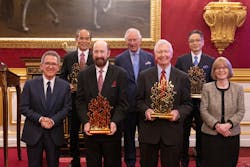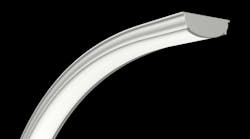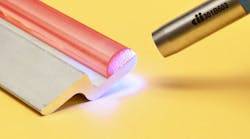London, UK: Today, His Royal Highness The Prince of Wales presented the 2021 Queen Elizabeth Prize for Engineering during a ceremony at St James’s Palace. The 2021 QEPrize laureates, Isamu Akasaki, Shuji Nakamura, Nick Holonyak Jr, M. George Craford and Russell Dupuis are recognised for the creation and development of LED lighting, which forms the basis of all solid state lighting technology. The engineers are recognised not only for the global impact of LED and solid state lighting but also for the tremendous contribution the technology has made, and will continue to make, to reducing energy consumption and addressing climate change.
Very sadly Professor Akasaki passed away in April 2021 but was represented at the ceremony by his son-in-law, Dr Kazuaki Takahashi. His Royal Highness presented each winner with a stunning gold trophy, whose designer and winner of the 2021 Create the Trophy competition, Hannah Goldsmith, was in attendance.
Solid state lighting technology has changed how we illuminate our world. It can be found everywhere from digital displays and computer screens to handheld laser pointers, automobile headlights and traffic lights. Today’s high-performance LEDs are used in efficient solid state lighting products across the world and are contributing to the sustainable development of world economies by reducing energy consumption.
Visible LEDs are now a global industry predicted to be worth over $108 billion by 2025 through low cost, high efficiency lighting. LED lighting is 75% more energy efficient than traditional incandescent and compact fluorescent bulbs, and is playing a crucial role in reducing carbon dioxide emissions. LED bulbs last 25 times longer than incandescent bulbs and their large-scale use reduces the energy demand required to cool buildings. For this, they are often referred to as the ‘green revolution’ within lighting.
“Engineering is imperative to solving human problems. All over the world, everyone knows the QEPrize. Most importantly, this is a team prize. I was able to do what I did in the 1980s, because of what had come before. When I was modifying reactors every morning and every afternoon continuously for a year and a half, I never thought it would be so successful.” Professor Shuji Nakamura
“This is a really special moment for me. The QEPrize is so prestigious and it is spectacular to receive recognition from The Royal Family. It is a career highlight that is impossible to beat. Engineering is incredible, and I am proud to part of something that has made such a big impact on the world.” Dr George Craford
“It is really something to share in this award win among my friends and colleagues – all five of us each played an important role, and this recognition means an awful lot. In those early days, when it was long days and nights hand-building reactors, Nick Holonyak mentored us. He really drew us in and inspired us to be part of the adventure that is engineering.” Professor Russell Dupuis
“This year’s Prize winners have not only helped humanity to achieve a greater degree of mastery over the environment, they have enabled us to do so in a sustainable way. They have created a product which we now take for granted, but which will play a major role in ensuring that humanity can live in harmony with nature for many more centuries to come.” Lord Browne of Madingley, Chairman, Queen Elizabeth Prize for Engineering Foundation
“The impact of this innovation is not to be understated. It makes lighting a lot cheaper and more accessible for emerging economies. For example, LEDs are being used on fishing boats where previously the only option would have been paraffin lamps. They are much cheaper and safer. It is not only an extreme engineering achievement, but a societal one that has a significant impact on the environment.” Professor Sir Christopher Snowden, Chair of the 2021 QEPrize Judging Panel
About the 2021 QEPrize
QEPrize celebrates engineering’s visionaries, encouraging engineers to help extend the boundaries of what is possible across all disciplines and applications. It also inspires young minds to consider engineering as a career choice and to help to solve the challenges of the future.
The QEPrize is administered by the Queen Elizabeth Prize for Engineering Foundation and funded by generous support from the following corporate donors: BAE Systems plc, BP plc, GlaxoSmithKline, Hitachi, Ltd., Jaguar Land Rover, National Grid plc, Nissan Motor Corporation, Shell UK Ltd, Siemens UK, Sony, Tata Steel Europe, Tata Consultancy Services, and Toshiba.
The 2021 winners are awarded a total cash prize of £1 million.
The 2021 prize was open to:
- up to five living individuals;
- of any nationality;
- who are personally responsible for a ground-breaking innovation in engineering which has been of global benefit to humanity. Self-nomination was not permitted.
- The trustees reserved the right to reject any nomination where, in their reasonable opinion, there was or was likely to be a conflict of interest between the nominees, nominators, or any referees and any other nomination or the prize more generally.
The judges use these criteria to select the winner, or winners, of the QEPrize:
- What is it that they have done that is a ground-breaking innovation in engineering?
- In what way has this innovation been of global benefit to humanity?
- Are there any other individuals who might claim to have had a pivotal role in this development?
About the QEPrize cycle transition from 2022
The QEPrize is increasing the frequency of its prize cycle from 2022 in order to offer greater opportunities to recognise engineering excellence.
Those awarded the QEPrize before 2021 received a total cash prize £1million – winners from 2022 onwards will receive £500,000. The entry and judging criteria remain the same.
About the Create the Trophy Competition
The QEPrize trophy is found through the Create the Trophy competition. The winning design is selected by a panel of expert judges from across the fields of engineering and design. The competition gives young people worldwide (aged 14-24) the opportunity to get involved, testing their design skills using the latest in 3D-design technology.
Contact:
QEPrize





